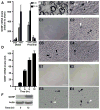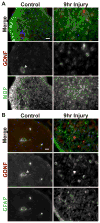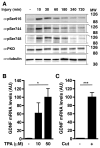Nerve injury induces glial cell line-derived neurotrophic factor (GDNF) expression in Schwann cells through purinergic signaling and the PKC-PKD pathway
- PMID: 23553603
- PMCID: PMC4165612
- DOI: 10.1002/glia.22491
Nerve injury induces glial cell line-derived neurotrophic factor (GDNF) expression in Schwann cells through purinergic signaling and the PKC-PKD pathway
Abstract
Upon peripheral nerve injury, specific molecular events, including increases in the expression of selected neurotrophic factors, are initiated to prepare the tissue for regeneration. However, the mechanisms underlying these events and the nature of the cells involved are poorly understood. We used the injury-induced upregulation of glial cell-derived neurotrophic factor (GDNF) expression as a tool to gain insights into these processes. We found that both myelinating and nonmyelinating Schwann cells are responsible for the dramatic increase in GDNF expression after injury. We also demonstrate that the GDNF upregulation is mediated by a signaling cascade involving activation of Schwann cell purinergic receptors, followed by protein kinase C signaling which activates protein kinase D (PKD), which leads to increased GDNF transcription. Given the potent effects of GDNF on survival and repair of injured peripheral neurons, we propose that targeting these pathways may yield therapeutic tools to treat peripheral nerve injury and neuropathies.
Copyright © 2013 Wiley Periodicals, Inc.
Figures






Similar articles
-
GDNF to the rescue: GDNF delivery effects on motor neurons and nerves, and muscle re-innervation after peripheral nerve injuries.Neural Regen Res. 2022 Apr;17(4):748-753. doi: 10.4103/1673-5374.322446. Neural Regen Res. 2022. PMID: 34472460 Free PMC article. Review.
-
A decline in glial cell-line-derived neurotrophic factor expression is associated with impaired regeneration after long-term Schwann cell denervation.Exp Neurol. 2002 Jan;173(1):77-85. doi: 10.1006/exnr.2001.7826. Exp Neurol. 2002. PMID: 11771940
-
Glial cell line-derived neurotrophic factor-induced signaling in Schwann cells.J Neurochem. 2005 Sep;94(6):1488-99. doi: 10.1111/j.1471-4159.2005.03290.x. Epub 2005 Aug 8. J Neurochem. 2005. PMID: 16086701
-
Enhancement of regeneration with glia cell line-derived neurotrophic factor-transduced human amniotic fluid mesenchymal stem cells after sciatic nerve crush injury.J Neurosurg. 2010 Apr;112(4):868-79. doi: 10.3171/2009.8.JNS09850. J Neurosurg. 2010. Retraction in: J Neurosurg. 2015 Dec;123(6):1606. doi: 10.3171/2015.7.JNS09850r. PMID: 19817545 Retracted.
-
Neurotrophins and glial cell line-derived neurotrophic factor in the ovary: physiological and pathophysiological implications.Hum Reprod Update. 2019 Mar 1;25(2):224-242. doi: 10.1093/humupd/dmy047. Hum Reprod Update. 2019. PMID: 30608586 Free PMC article. Review.
Cited by
-
Melatonin promotes Schwann cell dedifferentiation and proliferation through the Ras/Raf/ERK and MAPK pathways, and glial cell-derived neurotrophic factor expression.Exp Ther Med. 2020 Nov;20(5):16. doi: 10.3892/etm.2020.9143. Epub 2020 Aug 26. Exp Ther Med. 2020. PMID: 32934681 Free PMC article.
-
The use of fiber-reinforced scaffolds cocultured with Schwann cells and vascular endothelial cells to repair rabbit sciatic nerve defect with vascularization.Biomed Res Int. 2013;2013:362918. doi: 10.1155/2013/362918. Epub 2013 Dec 30. Biomed Res Int. 2013. PMID: 24490158 Free PMC article.
-
Glial cell-derived neurotrophic factor attenuates neuropathic pain in a mouse model of chronic constriction injury: possible involvement of E-cadherin/p120ctn signaling.J Mol Neurosci. 2014;54(2):156-63. doi: 10.1007/s12031-014-0266-y. Epub 2014 Mar 6. J Mol Neurosci. 2014. PMID: 24599758
-
GDNF to the rescue: GDNF delivery effects on motor neurons and nerves, and muscle re-innervation after peripheral nerve injuries.Neural Regen Res. 2022 Apr;17(4):748-753. doi: 10.4103/1673-5374.322446. Neural Regen Res. 2022. PMID: 34472460 Free PMC article. Review.
-
GDNF enhances human blood-nerve barrier function in vitro via MAPK signaling pathways.Tissue Barriers. 2018;6(4):1-22. doi: 10.1080/21688370.2018.1546537. Epub 2018 Dec 7. Tissue Barriers. 2018. PMID: 30523753 Free PMC article.
References
-
- Akkina SK, Patterson CL, Wright DE. GDNF rescues nonpeptidergic unmyelinated primary afferents in streptozotocin-treated diabetic mice. Exp Neurol. 2001;167(1):173–82. - PubMed
-
- Bampton ET, Taylor JS. Effects of Schwann cell secreted factors on PC12 cell neuritogenesis and survival. J Neurobiol. 2005;63(1):29–48. - PubMed
Publication types
MeSH terms
Substances
Grants and funding
LinkOut - more resources
Full Text Sources
Other Literature Sources

